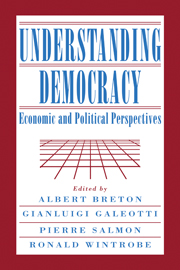Book contents
- Frontmatter
- Contents
- Contributors
- Introduction
- Part I Democracy, the market, and the law
- Part II Democracy and economic growth
- Part III Democratic deficiencies and possible improvements
- 8 Democracy and the public machinery: The case of the headless Leviathan
- 9 Democracy and empowerment
- 10 Political participation, voting, and economic policy: Three problems of modern democracies
- Part IV Democratic expectations
- Index
9 - Democracy and empowerment
Published online by Cambridge University Press: 05 December 2011
- Frontmatter
- Contents
- Contributors
- Introduction
- Part I Democracy, the market, and the law
- Part II Democracy and economic growth
- Part III Democratic deficiencies and possible improvements
- 8 Democracy and the public machinery: The case of the headless Leviathan
- 9 Democracy and empowerment
- 10 Political participation, voting, and economic policy: Three problems of modern democracies
- Part IV Democratic expectations
- Index
Summary
Introduction
We assume that the reality that is captured by the word democracy embodies mechanisms similar, though not identical, to those contained in the reality that is identified as the market; we further assume that democracy can be correctly analyzed and understood with the tools and methodology of conventional neoclassical economic theory which were crafted to analyze and understand markets. Given these two assumptions, no less than four analytical building blocks must be assembled to model democratic politics. The first building block must focus on the factors that give form to the demand side of politics; a second must concentrate on the variables that shape and determine supply; a third must be concerned with the forces that work to bring about a reconciliation of supply and demand–an equilibrating mechanism also capable of tracking how democracies adjust when they are subjected to external disturbances;–and a fourth must pay attention to the various devices (legal, cultural, social, political, and constitutional) that serve to enforce equilibrium outcomes.
Before proceeding with our discussion, we make two points regarding the above assumptions. First, democratic politics, like market calisthenics, can be more or less competitive and therefore more or less responsive to the preferences of citizens–to the demand side of politics. The degree of competition which, at any moment, distinguishes a democracy is the product, again as in markets, of structural and behavioral attributes of the organization of supply and of demand.
- Type
- Chapter
- Information
- Understanding DemocracyEconomic and Political Perspectives, pp. 176 - 195Publisher: Cambridge University PressPrint publication year: 1997
- 5
- Cited by



